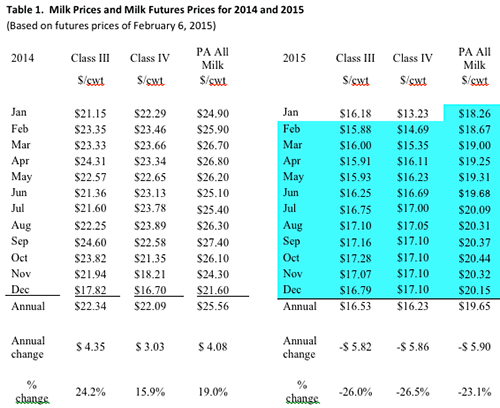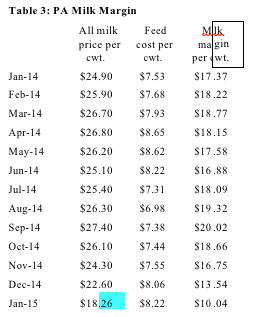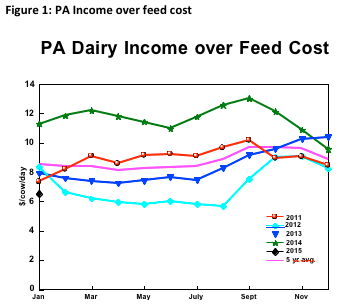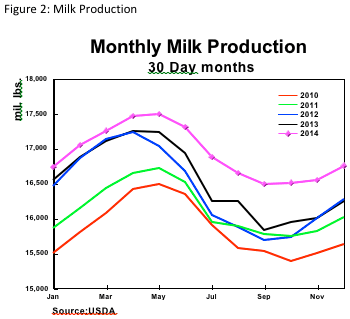
By Jim Dunn
Professor of Agricultural Economics, Penn State University
Market Psychology
Cheese and butter prices have risen in the past month, while the powdered product prices have fallen. The dollar is still very strong, with the Euro dropping to its lowest level in a decade. The European Union has resorted to its version of quantitative easing, increasing the money supply and lowering interest rates. U.S. dairy exports continue to be weak, with the dollar rising compared to the currencies of the other major dairy exporters. Despite fewer exports, milk production continues to grow. Butter prices rose by 30¢ in late January, from $1.54/lb. to $1.76. This price increase is related to an announcement by Fronterra that New Zealand milk production is expected to fall. Conditions both there and in Australia are dry and, with a grazing dairy herd, poor grass conditions have a significant production impact. Cheddar cheese had a similar response to the Fronterra report, but had suffered a price drop earlier in January that made the net change a one-half cent drop for the month to $1.565/lb. Both the skim-milk powder price and the dry whey price fell by 9% since last month.
Table 1 lists some past and estimated future milk prices. The USDA's monthly "Agricultural Prices" report has changed its reporting methods, and is no longer reporting a preliminary Pennsylvania all-milk price at the end of each month and is instead is reporting the January price at the end of February. I estimate the January price to be $18.26/cwt, down $3.34 from December, but the actual number will be released in early March. The preliminary price that USDA reported was based on the first half of the month and my estimate uses a different estimation method, based on historical relationships. We will see how it works going forward. The growth in milk production growth continues to be high, and the futures market prices for Class III and IV have stabilized. The January Class III price was down $1.64 from December at $16.18/cwt. The latest Class III futures prices for the rest of 2015 average $16.56, with Class III futures prices weaker through May, and higher prices for the remainder of 2015. The average Class III futures prices for all of 2015 are $16.53. The January Class IV price was down $3.47/cwt. from December at $13.23/cwt. The Class IV futures prices are higher for the remainder of 2015, averaging $16.50 for the next 11 months. My forecast all-milk prices for the 2015 average $19.65/cwt., or $5.90/cwt. below 2014.
The U.S. dollar is up against the Euro and the Australian and New Zealand dollars since my last report, with the Aussie dollar down 1.8% and the New Zealand dollar and the Euro down 5.6% and 5.0% respectively. The increase in the dollar over recent months has hurt all U.S. agricultural exports, including dairy products. With the falling exports, the increased milk production does not bode well for dairy prices, since our domestic market grows by much less than the recent milk production growth rate.
Corn and Soybean Markets
Corn and soybean meal prices have fallen since last month, by 5.7 and 11.2% respectively. Corn ended at $3.82/bu. for the March 2015 corn contract. Part of that is the added storage cost for a later delivery month and the rest is the effect of minor changes in supply and demand. Soybean meal has been oscillating in a narrow range and is now at $329.40 for March meal. The strong dollar and reductions in Mississippi River barge traffic because of accidents and repairs are reducing corn exports. China has cancelled some soybean import contracts, which further reduced these prices. Additionally, the South American soybean crop is expected to be good, especially in Argentina. The Chinese economy is struggling, which is hurting most agricultural commodity markets.
Income over Feed Costs (IOFC)
Penn State's measure of income over feed costs fell by 32% in January, as milk prices fell and feed prices rose. Figure 1 shows how these values compare to recent years. January's feed cost is 20¢/cow/day more than in December. January's value for IOFC of $6.53/cow/day is well below the December value of $9.55, although above most months' IOFC for 2013. The change is mainly because of the sharp drop in the milk price, while feed costs rose by 3.8%, with higher prices for corn, soybean meal and hay. Income over feed cost reflects daily gross milk income less feed costs for an average cow producing 65 pounds of milk per day. Figure 1 and Table 2 showing the monthly data follow.
The allocation of the revenue per hundred pounds of milk (milk margin) is shown in Table 3. The milk margin is the estimated amount of the Pennsylvania all milk price that remains after feed costs are paid. Like income over feed cost, this measure shows that the January PA milk margin was 32% lower than in December.
Milk Production
The latest milk production report showed December milk production up 3.1% from a year earlier, a sixth consecutive sizeable monthly increase (Figure 2). This is bearish, although the increase was expected. Once again, the growth in milk production was mostly in milk per cow rather than higher cow numbers. The national dairy herd this December is only 1% greater than in December 2013. The monthly cow numbers are shown in Figure 3.






2.9.2015